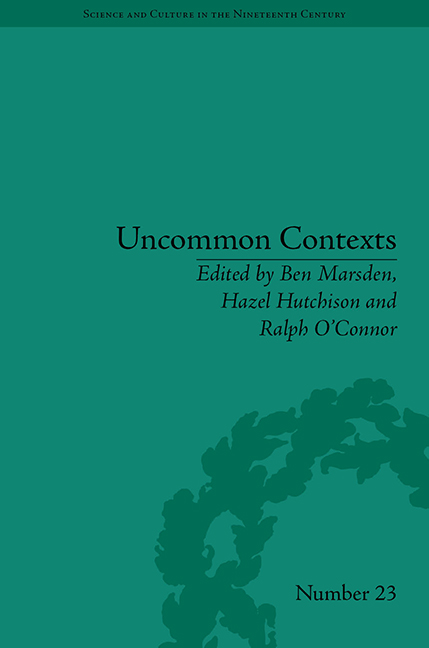Refine search
Actions for selected content:
10306 results in History of science: general interest
Introduction
-
- Book:
- The Transit of Venus Enterprise in Victorian Britain
- Published by:
- Pickering & Chatto
- Published online:
- 05 December 2014, pp 1-8
-
- Chapter
- Export citation
List of Figures and Tables
-
- Book:
- Natural History Societies and Civic Culture in Victorian Scotland
- Published by:
- Pickering & Chatto
- Published online:
- 05 December 2014, pp xi-xii
-
- Chapter
- Export citation
Part I - John Tyndall
-
- Book:
- The Age of Scientific Naturalism
- Published by:
- Pickering & Chatto
- Published online:
- 05 December 2014, pp -
-
- Chapter
- Export citation

Uncommon Contexts
- Encounters between Science and Literature, 1800–1914
-
- Published by:
- Pickering & Chatto
- Published online:
- 05 December 2014
-
- Book
- Export citation
8 - Francis Darwin, Cambridge and Plant Physiology
-
- Book:
- The Aliveness of Plants
- Published by:
- Pickering & Chatto
- Published online:
- 05 December 2014, pp 115-136
-
- Chapter
- Export citation
Index
-
- Book:
- The Aliveness of Plants
- Published by:
- Pickering & Chatto
- Published online:
- 05 December 2014, pp 221-227
-
- Chapter
- Export citation
Dedication
-
- Book:
- Vision, Science and Literature, 1870–1920
- Published by:
- Pickering & Chatto
- Published online:
- 05 December 2014, pp viii-viii
-
- Chapter
- Export citation
List of Illustrations
-
- Book:
- Styles of Reasoning in the British Life Sciences
- Published by:
- Pickering & Chatto
- Published online:
- 05 December 2014, pp ix-x
-
- Chapter
- Export citation
Index
-
- Book:
- Science and Societies in Frankfurt am Main
- Published by:
- Pickering & Chatto
- Published online:
- 05 December 2014, pp 229-235
-
- Chapter
- Export citation
Conclusion
-
- Book:
- Natural Science and the Origins of the British Empire
- Published by:
- Pickering & Chatto
- Published online:
- 05 December 2014, pp 133-134
-
- Chapter
- Export citation
Notes
-
- Book:
- Until Darwin, Science, Human Variety and the Origins of Race
- Published by:
- Pickering & Chatto
- Published online:
- 05 December 2014, pp 155-184
-
- Chapter
- Export citation
1 - Classification and the Species Question
-
- Book:
- Until Darwin, Science, Human Variety and the Origins of Race
- Published by:
- Pickering & Chatto
- Published online:
- 05 December 2014, pp 17-58
-
- Chapter
- Export citation
Index
-
- Book:
- Popular Exhibitions, Science and Showmanship, 1840–1910
- Published by:
- Pickering & Chatto
- Published online:
- 05 December 2014, pp 277-283
-
- Chapter
- Export citation
Acknowledgements
-
- Book:
- The Aliveness of Plants
- Published by:
- Pickering & Chatto
- Published online:
- 05 December 2014, pp vii-viii
-
- Chapter
- Export citation
6 - The ‘Great Plan of the Visible Universe’: William Huggins, Evolutionary Naturalism and the Nature of the Nebulae
- from Part II - Scientific Naturalism
-
-
- Book:
- The Age of Scientific Naturalism
- Published by:
- Pickering & Chatto
- Published online:
- 05 December 2014, pp 113-136
-
- Chapter
- Export citation
5 - The Steam Engine as Chemistry
- from II - Realities
-
- Book:
- James Watt, Chemist
- Published by:
- Pickering & Chatto
- Published online:
- 05 December 2014, pp 125-146
-
- Chapter
- Export citation
Acknowledgements
-
- Book:
- The Transit of Venus Enterprise in Victorian Britain
- Published by:
- Pickering & Chatto
- Published online:
- 05 December 2014, pp vii-viii
-
- Chapter
- Export citation
5 - The Sociology of Scientific Knowledge and the History of Science
-
- Book:
- The Historiography of the Chemical Revolution
- Published by:
- Pickering & Chatto
- Published online:
- 05 December 2014, pp 169-194
-
- Chapter
- Export citation

Styles of Reasoning in the British Life Sciences
- Shared Assumptions, 1820–58
-
- Published by:
- Pickering & Chatto
- Published online:
- 05 December 2014
-
- Book
- Export citation
2 - Trees and Taxonomy
-
- Book:
- The British Arboretum
- Published by:
- Pickering & Chatto
- Published online:
- 05 December 2014, pp 37-58
-
- Chapter
- Export citation
